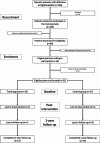High-intensity resistance training in patients with myositis - 1-year follow-up on a randomised controlled trial
- PMID: 40237840
- PMCID: PMC12003461
- DOI: 10.1007/s00296-025-05858-8
High-intensity resistance training in patients with myositis - 1-year follow-up on a randomised controlled trial
Abstract
Reduced quality of life in patients with myositis is partly due to impairments in muscle strength, muscle endurance and functional capacity. In a recent randomised controlled trial (RCT) (NCT04486261) we showed that high-intensity resistance training improved quality of life, muscle strength, and endurance. This follow-up study aimed to investigate if these improvements remained persistent one year after completing 16 weeks of high-intensity resistance training. A total of 32 participants (intervention group (IG): 15; control group (CG): 17) were enrolled in the RCT, with 27 (IG: 13; CG: 14) completing the 1-year follow-up. Outcomes were assessed at three time points: baseline (weeks - 4 - 0), post-intervention (weeks 17-18), and 1-year follow-up (weeks 52-54). Outcomes included quality of life (QoL, SF36), functional capacity, muscle endurance (functional index 3 (FI3)), body composition (DEXA), and disease activity/damage, including manual muscle test 8 (MMT8). Training-induced improvements in muscle endurance (FI3) remained at 1-year follow-up, with a mean change of 10.7 (CI95: 2.2;19.1) in favour of IG (p = 0.01). Within-group improvements in IG were sustained for QoL (SF36, physical component summary) (4.8 (CI95: 0.9;8.7), p = 0.02), muscle strength (MMT8) (1.8 (CI95: 0.8; 2.9), p < 0.01), and functional capacity measures (p ≤ 0.04), although not significantly different from CG at 1-year follow-up. Disease activity and disease damage were similar between IG and CG at 1-year follow-up. Patients with myositis completing 16 weeks of high-intensity resistance training showed sustained improvements in muscle endurance at 1-year follow-up compared to controls. Indications of lasting enhancements in quality of life and strength were also present, with no increase in disease activity or damage. NCT04486261.
Keywords: Strength training, non-pharmacological treatment, long-term exercise effects.
© 2025. The Author(s).
Conflict of interest statement
Declarations. Ethical approval: The study was approved by The Danish National Committee on Health Research Ethics (H-20030409) – 21/10-2020 and The Danish Data Protection Agency (P-2020–553) – 17/05-2020 and follows the Declaration of Helsinki. Disclaimer: No part of this manuscript, in its entirety, has been published elsewhere prior to this publication. It should be noted that both the baseline article (Jensen et al., 2024 [27]) and the RCT/intervention article (Jensen et al., 2024 [14]) include part of the demographics table, as it concerns the same cohort. Congress abstracts: Jensen KY, Aagaard P, Suetta C, et al. OP0065 effects of high-intensity resistance training for patients with myositis: 1-year follow-up on a randomised controlled intervention trial Annals of the rheumatic diseases 2024;83:95–96. Open access funding: The Copenhagen University Hospital, Rigshospitalet, has provided the funding for Open Access. Competing interests: The authors declare that they have no competing interests.
Figures
References
-
- Rider LG, Giannini EH, Harris-Love M, Joe G, Isenberg D, Pilkington C, Lachenbruch PA, Miller FW (2003) Defining clinical improvement in adult and juvenile myositis. J Rheumatol 30(3):603–617 - PubMed
-
- Wiesinger GF, Quittan M, Nuhr M, Volc-Platzer B, Ebenbichler G, Zehetgruber M, Graninger W (2000) Aerobic capacity in adult dermatomyositis/polymyositis patients and healthy controls. Arch Phys Med Rehabil 81(1):1–5. 10.1016/s0003-9993(00)90212-0 - PubMed
-
- Lundberg IE, Fujimoto M, Vencovsky J, Aggarwal R, Holmqvist M, Christopher-Stine L, Mammen AL, Miller FW (2021) Idiopathic inflammatory myopathies. Nat Rev Dis Primers 7(1):86. 10.1038/s41572-021-00321-x - PubMed
-
- Zong M, Lundberg IE (2011) Pathogenesis, classification and treatment of inflammatory myopathies. Nat Rev Rheumatol 7(5):297–306. 10.1038/nrrheum.2011.39 - PubMed
Publication types
MeSH terms
Associated data
LinkOut - more resources
Full Text Sources
Medical



